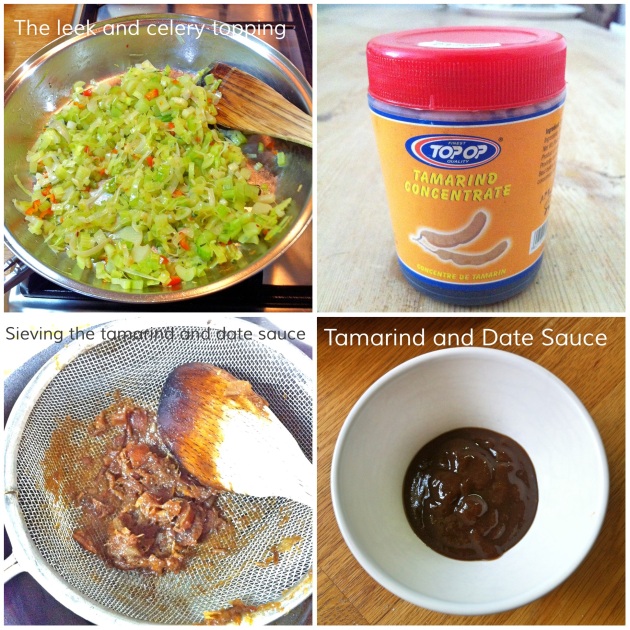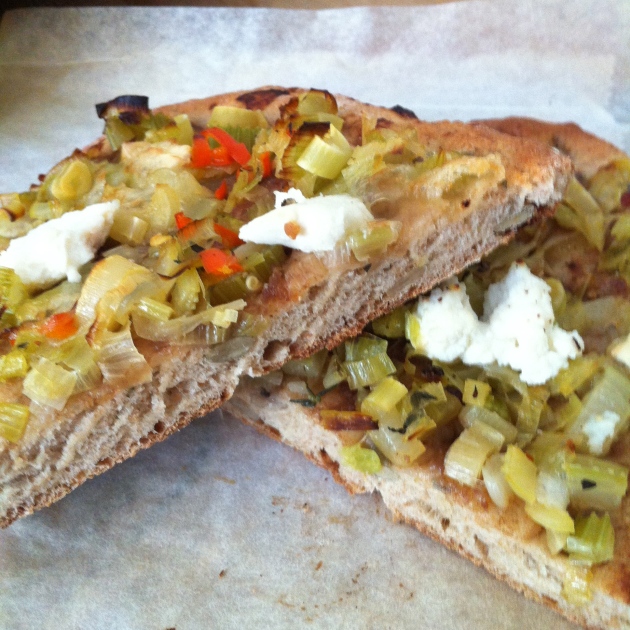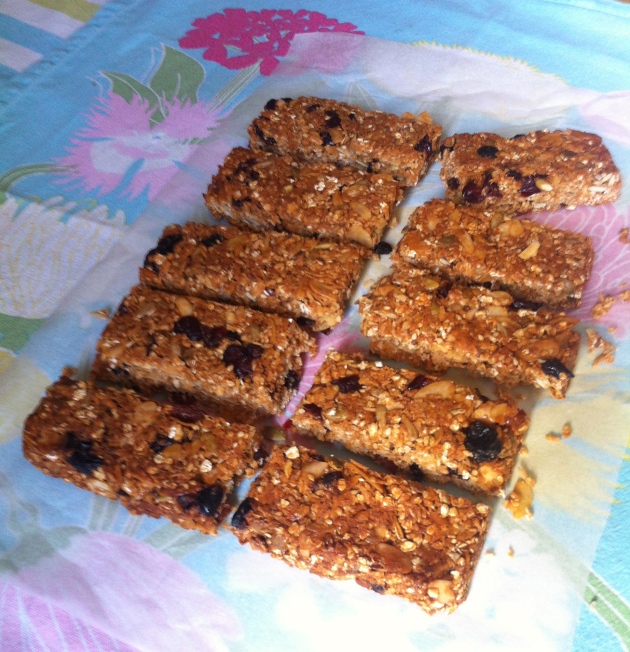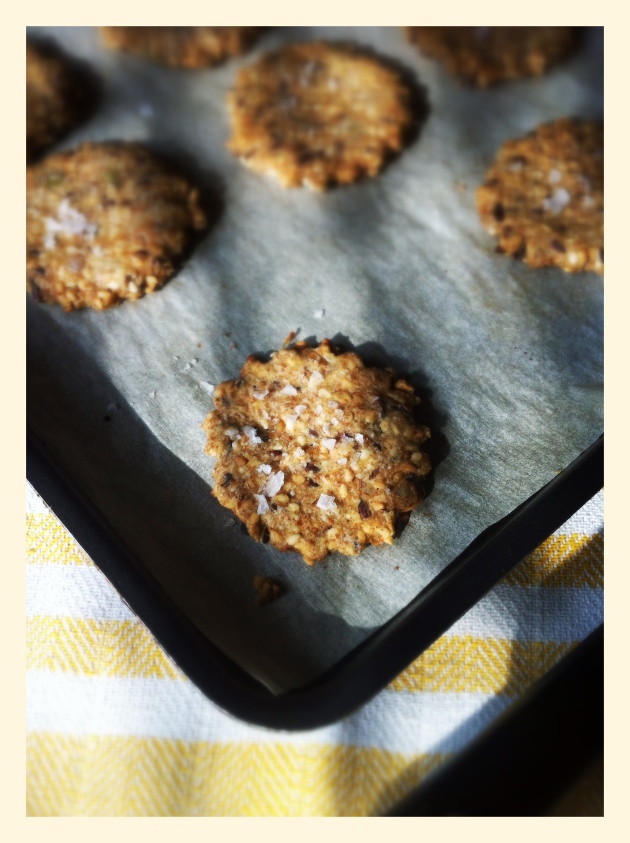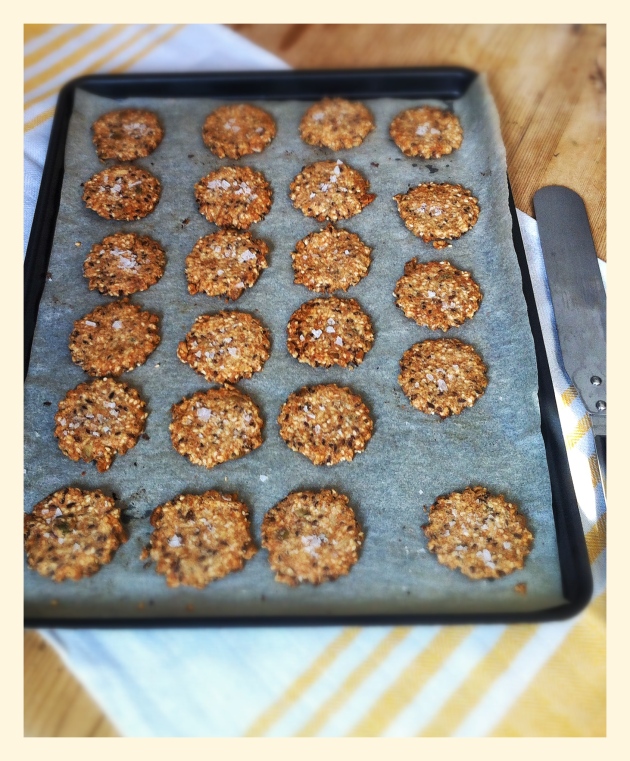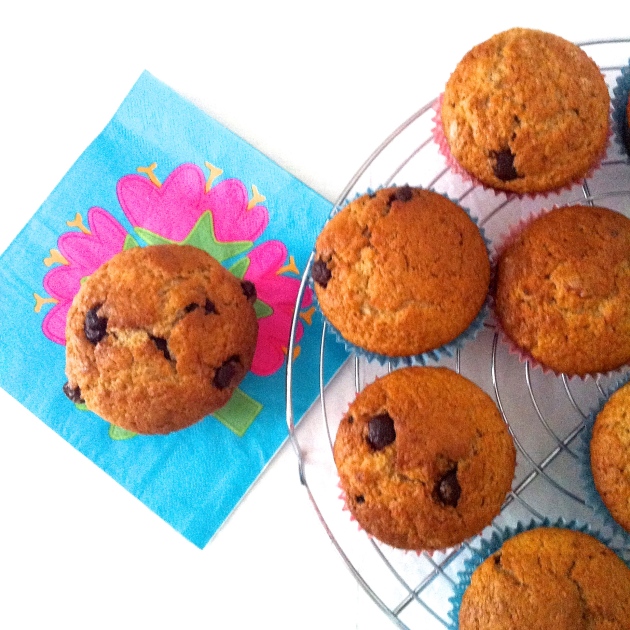 I am always surprised at how many people buy those cakey muffins at coffee shops to take back to their desks, either in the morning or at break times. Or the people who buy them in packs from the supermarkets – you know the ones full of preservatives and correspondingly long sell by dates. Muffins are so easy to make with the added bonus of being fresh and with ingredients that you are able to control and can pronounce the names of. In less than 45 minutes you can be sitting down to a warm freshly baked muffin and a cuppa, smug in the knowledge that you have 11 more to pack into lunch boxes or dish up as an after school snack with a glass of milk for the kids. They can be as healthy or as sinful as you like. It’s entirely up to you and what you have in your larder/pantry. I haven’t tried to freeze them, mainly because they don’t last that long – I used to always pack extra for Jake to share with his lunchtime gang. If you try freezing them, let me know in the comments and I will edit this post to include your thoughts, with a credit to you of course!
I am always surprised at how many people buy those cakey muffins at coffee shops to take back to their desks, either in the morning or at break times. Or the people who buy them in packs from the supermarkets – you know the ones full of preservatives and correspondingly long sell by dates. Muffins are so easy to make with the added bonus of being fresh and with ingredients that you are able to control and can pronounce the names of. In less than 45 minutes you can be sitting down to a warm freshly baked muffin and a cuppa, smug in the knowledge that you have 11 more to pack into lunch boxes or dish up as an after school snack with a glass of milk for the kids. They can be as healthy or as sinful as you like. It’s entirely up to you and what you have in your larder/pantry. I haven’t tried to freeze them, mainly because they don’t last that long – I used to always pack extra for Jake to share with his lunchtime gang. If you try freezing them, let me know in the comments and I will edit this post to include your thoughts, with a credit to you of course!
 I haven’t made muffins recently but I had three very ripe bananas that needed using up and found myself pulling out the muffin pan…these ones are banana, cinnamon and chocolate chip.
I haven’t made muffins recently but I had three very ripe bananas that needed using up and found myself pulling out the muffin pan…these ones are banana, cinnamon and chocolate chip.
This recipe is one that I have been using for many years – I have tweaked it and tweaked it over time to suit all the ingredient changes that I have made. Adding buttermilk or the more easily available yoghurt keeps the crumb really moist.
All you need by way of kitchen equipment is;
- a regular 12 hole muffin tray and cupcake liners
- two mixing bowls plus a smaller heatproof one to melt the butter in
- electronic scales – if you don’t have one, please, please add it to your wish list as it is the most accurate way to measure out ingredients, especially for baking. If you set your mixing bowl on the scales and set it to zero then you can just keep adding your dry ingredients to it (re-setting to zero each time) which keeps the washing up to a minimum too.
- a small hand whisk
- a measuring teaspoon
- a rubber spatula
- a large spoon to scoop out the dry ingredients with and then to fill the muffin cups with.
The basic premise is to put all the dry ingredients into the larger mixing bowl and whisk well to aerate and combine. I add any dried fruit or chocolate chips at this stage too as the flour coating helps them not to sink to the bottom. Use a smaller mixing bowl for the wet ingredients. I mash my very ripe bananas straight into this bowl after whisking the egg. The buttermilk comes in a 300ml carton, and if you decide to use a yoghurt pot then just use that to fill the milk up in it – no need for a measuring jug! Pour the wet ingredients onto the dry ingredients. Stir lightly – streaks (but not large pockets) of flour are desirable. Scoop into muffin cups. Top with seeds or nuts if using. Bake. Cool and enjoy!
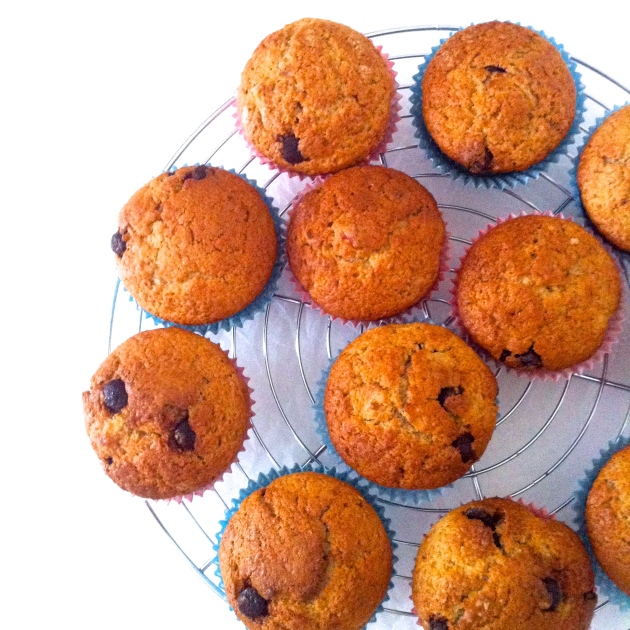
I am taking these over to the friendliest party around – Angie’s Fiesta Friday #26. Today we have two talented co-hosts who are not only fabulous and creative cooks but who can also spin a yarn or two. Prudy @ Butter Basil and Breadcrumbs and Jess @ Cooking Is My Sport. Let’s party!!
Basic Buttermilk Muffins with Variations
INGREDIENTS
- 250 g plain/AP flour
- 150 g golden caster/superfine sugar – you can just use the normal white version too
- 2 tsp baking powder
- ½ tsp baking soda
- 1/4 tsp table salt
- 1 large free range egg
- 300 ml buttermilk (or 125 ml yoghurt/creme fraiche/ sour cream plus 125ml milk)
- 80 g melted unsalted butter
Delicious variations- not ALL at the same time!!
General additions and subs:
- sunflower seeds, walnuts, pecans- as a topping
- 125 g blueberries/raisins/ chopped dried apricots/chopped dates etc
- 25 g coconut flakes – reduce flour by 25 g
- 100 g spelt or buckwheat flour – reduce flour by 100 g
- 50 g jumbo oats – reduce flour by 50 g
Banana and Chocolate Chip Muffins
- 1 tsp cinnamon
- 3 very ripe bananas
- 80 g chocolate chips
Blueberry, Lemon and Poppy Seed Muffins (Lovely with a little lemon and icing sugar glaze)
- zest of 1 lemon
- 1 Tbsp poppy seeds
- 125 g blueberries
Carrot Cake Muffins (Delicious with a little honeyed cream cheese topping)
- 125 g grated carrot
- 80 g soaked and drained sultanas or raisins
- ½ tsp cinnamon
- ½ tsp mixed spice
- Replace butter with 80 ml of oil
Coconut, Raspberry and White Chocolate Chip Muffins
- 125 g raspberries
- 25 g coconut flakes – reduce flour by 25 g
- 80 g white chocolate chips
INSTRUCTIONS
- Pre-heat oven to 180C/350F/. Prepare a 12 hole muffin tin with liners or grease them well
- Pop the butter in a heat proof bowl and place in the oven for 5 minutes (set the timer!!) while it is heating up.
- In a medium mixing bowl, hand whisk the egg. If you are going to add bananas, add them now and mash with a fork – I like to leave them a little chunky . Add the buttermilk or yoghurt/creme fraiche/sour cream and milk mixture and whisk to combine everything.
- In a large mixing bowl, measure out the flour, the oats and or coconut if using, the sugar, the baking powder , the salt and chocolate chips or raisins or cinnamon or lemon zest and poppy seeds if using. Whisk well to aerate and to combine all the ingredients. Make a well in it and set aside.
- Slowly pour in the melted butter onto the egg/buttermilk mixture, whisking all the while to mix in the butter evenly which will begin to solidify as it hits the cold liquid.
- Pour in the wet ingredients onto the dry and stir to mix. Do not over mix – leave some streaks of flour but not huge pockets of it!
- Stir in any delicate berries at this point.
- Divide the mixture between the 12 muffin cups and top with the seeds or nuts if using.
- Bake for 20-25 minutes until golden brown. Test with a wooden skewer (or a piece of uncooked spaghetti!) – if there is any batter clinging to it, pop the tray back in for a 2 or 3 minutes.
- Cool in the pan for 5 minutes then remove to a wire rack to cool off completely.
© Selma Jeevanjee and Selma’s Table, 2013, 2014. Unauthorised use and/or duplication of this material, including photographs without express and written permission from this blog’s author and/or owner is strictly prohibited. Excerpts and links may be used, provided that full and clear credit is given to Selma Jeevanjee and Selma’s Table with appropriate and specific direction to the original content.


 It’s time for
It’s time for 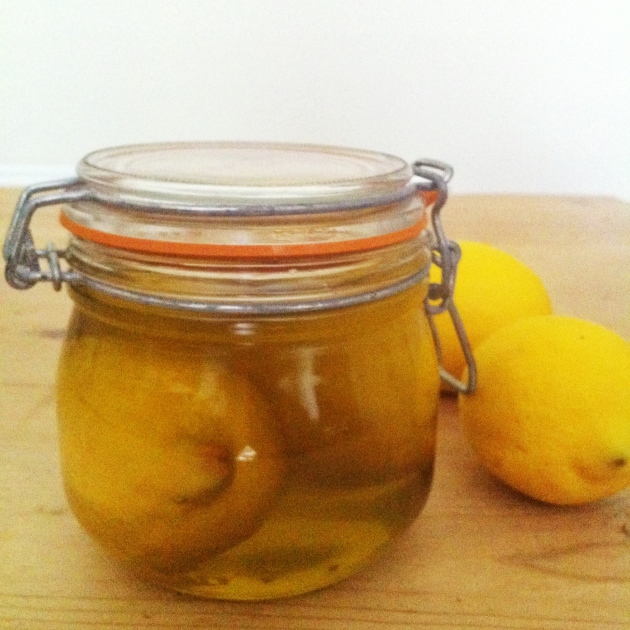 The second recipe is for Dukkah – a coarse Middle Eastern nut, seed and spice blend that is ridiculously versatile. Traditionally, it is served in a small bowl alongside another of olive oil and some warm flatbread. The bread is dipped in the oil and then in the spice blend. It can also be used to sprinkle over hoummus, fried or boiled eggs, tossed with Mediterranean vegetable before roasting and used to coat tiny tender lamb chops before cooking. Claudia Roden published the first recipe for Dukkah, outside of Egypt in A Book of Middle Eastern Food, back in 1968. Every family has a different version of this which is kept in a large jar in the pantry. It is just a matter of toasting the nuts, seeds and spices, before grinding coarsely.
The second recipe is for Dukkah – a coarse Middle Eastern nut, seed and spice blend that is ridiculously versatile. Traditionally, it is served in a small bowl alongside another of olive oil and some warm flatbread. The bread is dipped in the oil and then in the spice blend. It can also be used to sprinkle over hoummus, fried or boiled eggs, tossed with Mediterranean vegetable before roasting and used to coat tiny tender lamb chops before cooking. Claudia Roden published the first recipe for Dukkah, outside of Egypt in A Book of Middle Eastern Food, back in 1968. Every family has a different version of this which is kept in a large jar in the pantry. It is just a matter of toasting the nuts, seeds and spices, before grinding coarsely.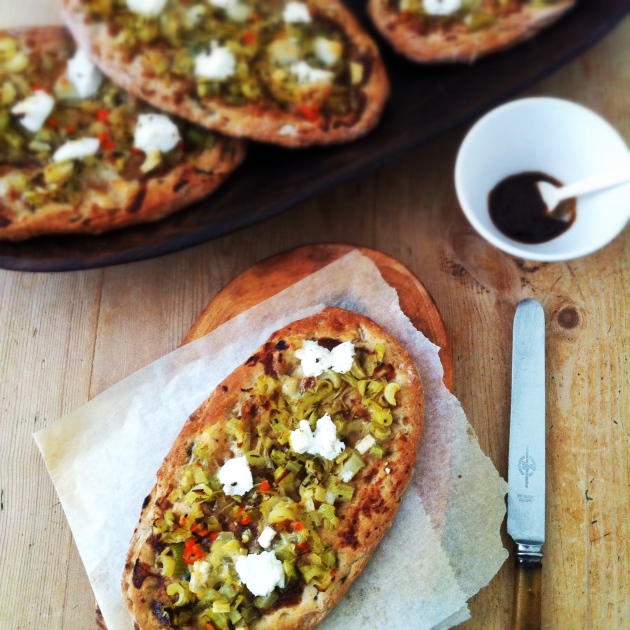 It’s funny how inspiration strikes. Aware that the clock was counting down fast on the deadline for submitting a ‘yeast and herb’ based post for Angie’s first
It’s funny how inspiration strikes. Aware that the clock was counting down fast on the deadline for submitting a ‘yeast and herb’ based post for Angie’s first 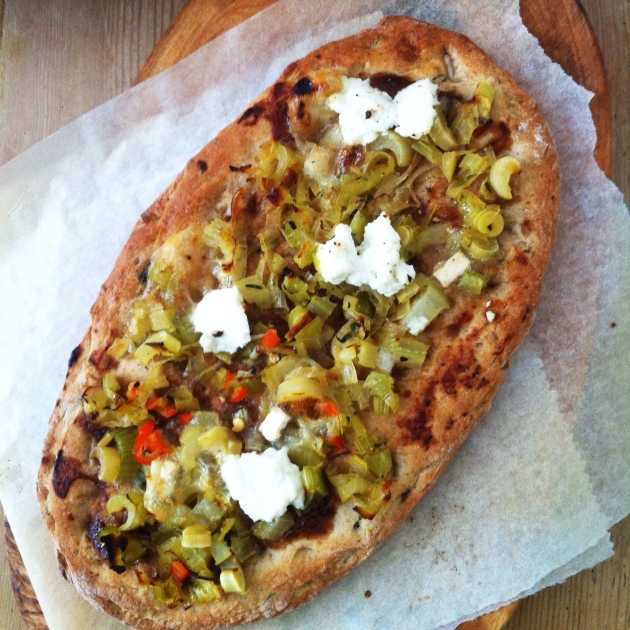
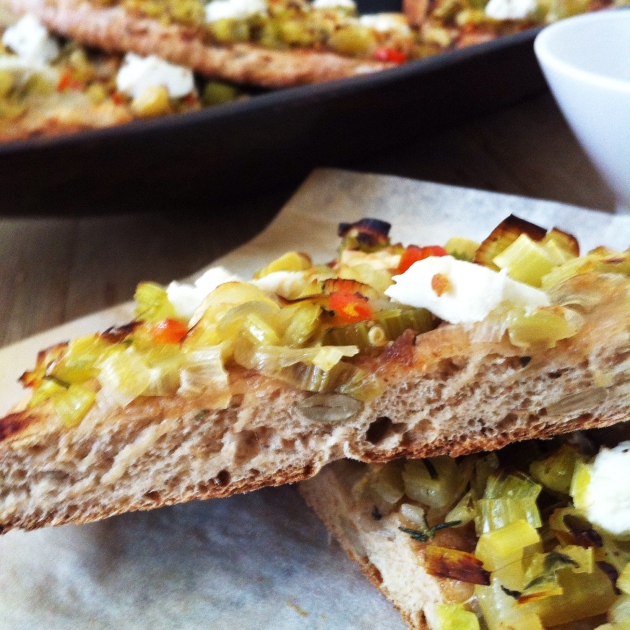 Once baked, the goat’s cheese has melted and the creamy ricotta is a wonderful counterpoint to the heat from the chilli flakes and the crunch of the seeds. Next time I will add more ricotta (I’ve updated the recipe below to account for this). Angie is being very ably assisted by
Once baked, the goat’s cheese has melted and the creamy ricotta is a wonderful counterpoint to the heat from the chilli flakes and the crunch of the seeds. Next time I will add more ricotta (I’ve updated the recipe below to account for this). Angie is being very ably assisted by  Ever since I attended
Ever since I attended 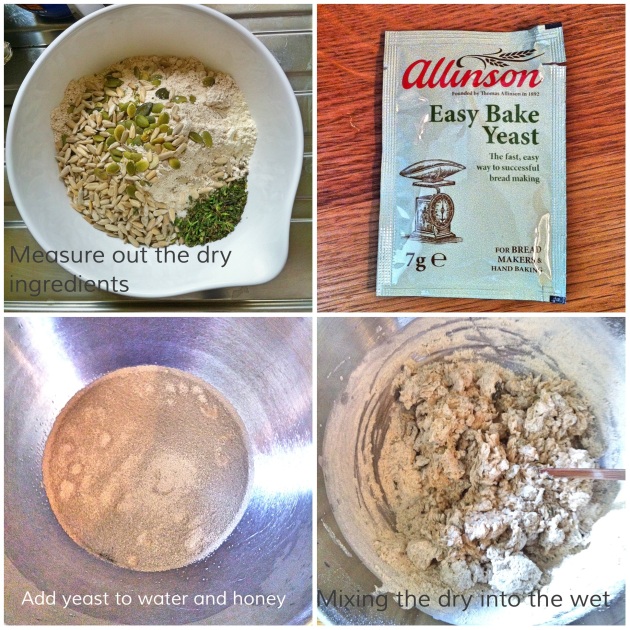 I used a chopstick to roughly mix the dry ingredients into the wet, thanks to a tip from
I used a chopstick to roughly mix the dry ingredients into the wet, thanks to a tip from 